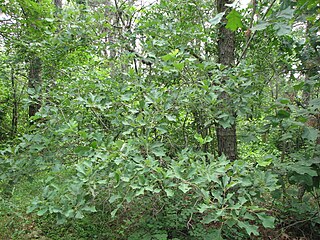
An oak is a hardwood tree or shrub in the genus Quercus of the beech family. They have spirally arranged leaves, often with lobed edges, and a nut called an acorn, borne in a cup. The genus is widely distributed in the Northern Hemisphere; it includes some 500 species, both deciduous and evergreen. Fossil oaks date back to the Middle Eocene. Molecular phylogeny shows that the genus is divided into Old World and New World clades, but many oak species hybridise freely, making the genus's history difficult to resolve.

Quercus alba, the white oak, is one of the preeminent hardwoods of eastern and central North America. It is a long-lived oak, native to eastern and central North America and found from Minnesota, Ontario, Quebec, and southern Maine south as far as northern Florida and eastern Texas. Specimens have been documented to be over 450 years old.

Quercus palustris, also called pin oak, swamp oak, or Spanish oak, is a tree in the red oak section of the genus Quercus. Pin oak is one of the most commonly used landscaping oaks in its native range due to its ease of transplant, relatively fast growth, and pollution tolerance.

Quercus macrocarpa, the bur oak or burr oak, is a species of oak tree native to eastern North America. It is in the white oak section, Quercus sect. Quercus, and is also called mossycup oak, mossycup white oak, blue oak, or scrub oak. The acorns are the largest of any North American oak, and are important food for wildlife.

Quercus lyrata, the overcup oak, is an oak in the white oak group. The common name, overcup oak, refers to its acorns that are mostly enclosed within the acorn cup. It is native to lowland wetlands in the eastern and south-central United States, in all the coastal states from New Jersey to Texas, inland as far as Oklahoma, Missouri, and Illinois. There are historical reports of it growing in Iowa, but the species appears to have been extirpated there. It is a slow-growing tree that often takes 25 to 30 years to mature. It has an estimated lifespan of 400 years.

Quercus ilicifolia, commonly known as bear oak or scrub oak, is a small shrubby oak native to the Eastern United States and, less commonly, in southeastern Canada. Its range in the United States extends from Maine to North Carolina, with reports of a few populations north of the international frontier in Ontario. The name ilicifolia means "holly-leaved."

Bucculatrix ainsliella, the oak leaf skeletonizer or oak skeletonizer, is a moth species of the family Bucculatricidae. It is found in the northern part of the United States, down to North Carolina and Mississippi and the Southern parts of Canada, including British Columbia. In 2011 it was discovered in the Netherlands and Belgium. It was first described in 1905 by Mary Murtfeldt.

Bucculatrix canadensisella, the birch skeletonizer, is a moth of the family Bucculatricidae. The species was first described by Vactor Tousey Chambers in 1875. It is found in North America. In Canada, it has been recorded from New Brunswick to British Columbia, Nova Scotia and Prince Edward Island. In the United States, it has been recorded from New York, New Jersey, Michigan, Wisconsin, Minnesota, Pennsylvania, North Carolina, Tennessee, Kentucky and Colorado.

Bucculatrix ulmella is a moth of the family Bucculatricidae. It is found in most of Europe, except the Iberian Peninsula, Slovenia and Bulgaria. It was first described in 1848 by Philipp Christoph Zeller.
Bucculatrix quinquenotella is a species of moth of the family Bucculatricidae. It is found in North America, including Kentucky, Ohio, Michigan, Missouri, Iowa, Tennessee, Georgia, South Carolina, North Carolina, Washington D.C., New Jersey, Massachusetts, New Hampshire, Ontario, Quebec and Nova Scotia. It was described in 1875 by Vactor Tousey Chambers.
Bucculatrix needhami is a moth in the family Bucculatricidae. It was first described in 1956 by Annette Frances Braun. It is found in North America, where it has been recorded from Florida, Kentucky, Illinois, Maine, New York, Ohio, South Carolina and Texas.
Bucculatrix cuneigera is a moth in the family Bucculatricidae. It is found in North America, where it has been recorded from Quebec, Ontario, New Brunswick, Nova Scotia, Maine, Ohio, New York, Massachusetts and North Carolina. It was described by Edward Meyrick in 1919.
Bucculatrix eupatoriella is a moth in the family Bucculatricidae. It is found in North America, where it has been recorded from Ohio and North Carolina. It was described in 1918 by Annette Frances Braun.
Bucculatrix packardella is a moth in the family Bucculatricidae. It was described by Vactor Tousey Chambers in 1873. It is found in North America, where it has been recorded from Ohio, Maine, Michigan, Ontario, Pennsylvania, Washington D.C., Delaware, New Jersey, New York and Rhode Island.
Bucculatrix ochrisuffusa is a moth in the family Bucculatricidae. It is found in North America, where it has been recorded from Ohio. It was described in 1963 by Annette Frances Braun.
Bucculatrix trifasciella is a moth in the family Bucculatricidae. It was first described by James Brackenridge Clemens in 1866 and is found in North America, where it has been recorded from Maine, New Hampshire, Pennsylvania, New Jersey, Kentucky, Ohio and Ontario.
Bucculatrix domicola is a moth in the family Bucculatricidae. It is found in North America, where it has been recorded from Ohio and New Jersey. It was first described in 1963 by Annette Frances Braun.
Bucculatrix zophopasta is a moth in the family Bucculatricidae. It was described by Annette Frances Braun in 1963 and is found in North America, where it has been recorded from British Columbia, Oregon and California.
Bucculatrix recognita is a moth in the family Bucculatricidae. It was described by Annette Frances Braun in 1963 and is found in North America, where it has been recorded from Ontario, Maine, New Hampshire, Massachusetts, Missouri, New Jersey, Washington, D.C., North Carolina and South Carolina.
Bucculatrix pomifoliella is a moth in the family Bucculatricidae. It was described by James Brackenridge Clemens in 1860 and is found in North America, where it has been recorded from Pennsylvania, Virginia, New Jersey, New York, Massachusetts, Maine, Ontario, Ohio, Tennessee, North Carolina, Missouri, Utah, Washington, British Columbia, Indiana, Manitoba, Quebec and West Virginia.








